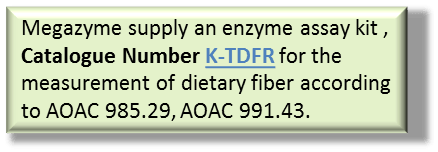The history of dietary fiber dates back to ancient Greece where it was known that bran cereals helped to prevent constipation. In the 1930s, J.H. Kellogg confirmed the positive effects of wheat bran on patients suffering with colitis and constipation but it was not until 1953 that Dr. Eben Hipsley coined the phrase “dietary fiber” in an article on pregnancy toxaemia.1
Throughout the 1970s, British researchers, Denis Burkitt and Hugh Trowell, became leaders in the field proposing the “dietary fiber hypothesis” and the concept of “Western diseases”. Having spent a significant time studying populations in sub-Saharan Africa, they reached the conclusion that the lack of unprocessed, high fiber foods in typical Western diets led to a higher incidence of certain conditions including heart disease and colorectal cancer.2,3,4
Hugh Trowell is credited with the first acceptable definition of dietary fiber.5,6



Following on from this a number of research groups began to focus on improving the methodology available for the measurement of dietary fiber content; Southgate,7 Theander,8 Schweizer,9 Furda,10 Heckman,11 Baker,12 and Asp13 being the major contributors at this time. Their goal was to develop a method of analysis that could be used to quantify dietary fiber as defined by Trowell.
By 1985, Leon Prosky had successfully led a collaborative effort to reach consensus within the scientific community on dietary fiber methodology. This was accomplished through an interlaboratory study that resulted in the acceptance of AOAC 985.29 / AACC 32.05 as the reference method for the analysis of dietary fiber. 14,15 This method was widely welcomed by the food science community, servingas a reliable, reproducible analytical tool for the food and beverage industries. A series of related methods for the measurement of dietary fiber followed and were also approved by AOAC. The most useful of these was a simple extension of the Prosky method which allowed the measurement of soluble and insoluble dietary fiber separately (Lee method – AOAC 991.43).16

Scientific surveys in the early 1990s began to highlight a deficiency in the definition of dietary fiber.17,18 A growing body of evidence existed for the inclusion of resistant starch and non-digestible oligosaccharides in total dietary fiber because these food ingredients exhibited many of the health benefits claimed for dietary fiber. These components were not measured by the “gold standard” Prosky method (AOAC 985.29) or its soluble/insoluble extension – AOAC 991.43. The analytical community responded to this challenge by developing both entirely new methods and extensions to existing methods. For example, dietary fiber including non-digestible oligosaccharides could be measured using the Matsutani method (AOAC 2001.03)19 but the quantification of resistant starch posed a more serious problem.
Resistant Starch as a basis for the MCCleary Integrated Total Dietary Fiber method (AOAC 2009.01)
The Prosky method (AOAC 985.29) could never be used for the measurement of resistant starch because the harsh incubation conditions (100ºC, pH 8.2) during enzymatic hydrolysis ensured that the starch content in the sample was completely gelatinised removing any ‘resistant’ component. Throughout the 1980s a number of research groups (Champ,20 Berry,21 Englyst,22 and Muir and O’Dea23) turned their attention to a method for the measurement of resistant starch and sought to develop a method using pseudo-physiological incubation conditions for the required enzymatic digestion step. McCleary et al.24 ultimately developed a method employing pancreatic α-amylase in place of bacterial α-amylase at pH 6, 37ºC, which could successfully be used to reproducibly measure resistant starch. This was the only resistant starch method that survived the thoroughness of an interlaboratory evaluation and was accepted by AOAC as an official method (AOAC 2002.02).25


Following intensive research, it was shown that the incubation step developed for the resistant starch method (with very minor modifications) was also suitable for the measurement of HMWDF. The mild, physiologically relevant, conditions employed ensured that the starch present in a sample was not gelatinised and could be accurately measured as a component in dietary fiber. The precipitation step for the isolation of HMWDF was used as in AOAC 985.29 to maintain the previous molecular weight cut-off and the HPLC analysis of the filtrate following this precipitation was performed as described in the Matsutani method (AOAC 2001.03) to guarantee correct measurement of non-digestible oligosaccharides. The amalgamation of all of these features resulted in the McCleary method26 for Integrated Total Dietary Fiber (AOAC 2009.01)27 and its soluble/insoluble method extension (AOAC 2011.25).28

The McCleary method is now the only method that correctly measures all components of dietary fiber as defined by CODEX Alimentarius.
CODEX Alimentarius definition of dietary fiber: